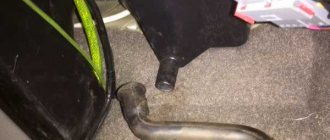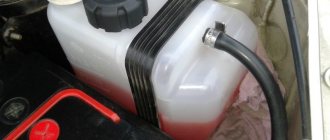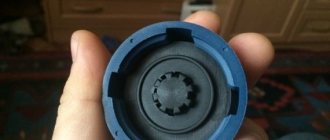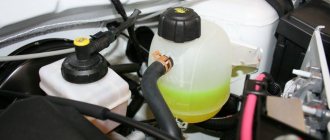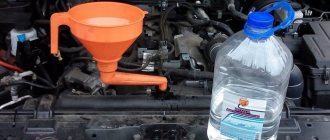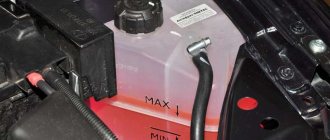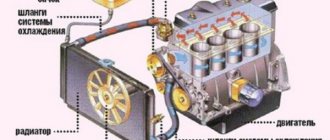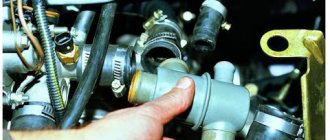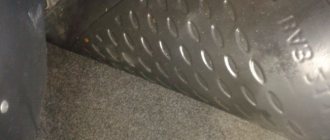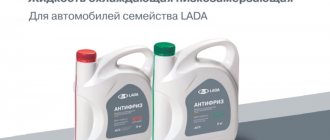98450km. 03/14/15 From the very beginning of the winter cold (and one might say that it started last winter), I began to generously add antifreeze, which also flowed abundantly in the area of the main radiator... (Upon inspection, I found wet honeycombs near the rolling of the cans). Last winter I drove 15 thousand km and added 1.5...2 liters, but this winter with the same mileage almost 8 liters of antifreeze was added! and I’m absolutely tired of it! Two months ago I decided to buy a radiator and... here a surprise awaited me! — due to problems with the supply of original radiators from the Dmitrovograd plant, local hucksters raised the price for them from 2000 rubles to 6000 rubles
, which did not please me at all... And then, strangely enough, the “officials” came to my rescue! After calling one of the dealers I heard a price tag of 1600 rubles! — I didn’t even think twice and took the radiator (new, original and very cheap). I was very interested in the packaging of the radiator upon receipt from the warehouse - a regular corrugated cardboard wrapper tied with tape
In general, I bought a radiator and a set of hoses and postponed the replacement until it warms up...
And just three days ago in the morning I saw a gorgeous pink puddle under the car and a wet bumper...
Well, it’s time to replace the radiator, I decided, and went to the garage.
Having opened the hood and looked at all this constructive disgrace (and I also have an air conditioner), I picked up the grinder and removed the radiator frame!
(more details in the next blog).
After which I very calmly took out the radiators along with the fan frame.
The radiator was quite dry, but with pink streaks along the cans... - a definite replacement! but where does this flow from?
And then I noticed the right side member
and it dawned on me - the expansion tank was leaking. I took it off, examined it, made sure... But, as it turned out, my tank died not like everyone else’s - it “torn”, but simply cracked from old age along all the ribs.
As a result of the repair, I took such a pile to the trash
Source
Chevrolet Niva Little horse › Logbook › Antifreeze leak
When I was fiddling with the power steering I discovered where the antifreeze was leaking from. And it flowed from the connection of the hose with the tank, then flowed down the hose to the pump and partly along the spar forward, just as if it was flowing from the radiator. Having read horror stories here about barrels bursting, I decided to remove it the next day and inspect it. It turns out that the pipe was already sitting on gray (apparently something cheap) sealant. But I think the reason is a rough seam on the tank fitting. While the sealant was fresh and elastic, it sealed this rough protrusion, but then it began to crumble and water found its way.
I cleaned and smoothed these rough seam protrusions.
So I wasn’t completely sure that the old hose would fit tightly around the fitting, so I decided to assemble it with a sealant. I didn’t buy a tube of VictorReinz, I took a simple black ABRO.
Since the hose is already a little stiff, it may not be able to be compressed by the original spring clamp. I installed a new stainless steel clamp, and tightened the spring clamp to the thickening for a better seal.
I didn’t fill it up and check it on the same day. Just today I filled it with antifreeze and started it to warm it up. I wrapped the area where the leak was in toilet paper so that I could immediately see if there was a leak. Started it up and bled the power steering while the engine was running. And I didn’t find any leaks.
There is no longer a leak in this place, but as it warmed up I noticed that the radiator was slightly steaming in this place.
I examined the radiator, the honeycombs themselves near the barrels are sweating. There is nothing like that on the pipes. I don't like the expansion tank cap, apparently it's stuck and doesn't release excess pressure. What could have caused the damage to the radiator? Now you still need to buy a radiator and a cover. And I still don’t know what’s wrong with the heater radiator; I don’t even know how to get to it.
Source
Why does antifreeze go away?
One of the common problems that arise with the engine cooling system is a fluid leak. Due to low levels of antifreeze, problems may occur with both the engine itself and parts of the cooling system. Therefore, the fluid level in the expansion tank must be regularly monitored and not allowed to drop below MIN. You can determine that antifreeze is running out by the following signs:
A change in coolant level from minimum to maximum is normal.
The most common reason why coolant leaves the system is damage to the main radiator of the cooling system. The malfunction can be diagnosed by smudges on the unit body or a puddle under the car after parking. Damage to the heat exchanger can be caused by the following factors:
A leak in the radiator is possible both through the honeycombs and through the tanks
The design of the radiator consists of many honeycombs through which coolant circulates. Even the slightest damage to one of them will lead to leakage. To diagnose a breakdown, you will need to remove the heat exchanger from the car, assess the nature of the damage and try to restore the seal by soldering or argon welding.
You can try to restore the cooling radiator by soldering or welding
Sometimes there is a leak in the interior heater core. The problem manifests itself as a puddle of coolant under the front passenger's carpet, as well as a foggy windshield. In this case, the radiator will have to be removed from the car to identify the damaged area and carry out similar measures as with the main radiator.
The heater radiator, by analogy with the main radiator, can be damaged as a result of corrosion
If the leak is caused by a leak in the faucet, drops of antifreeze will be visible on it. The device, as a rule, cannot be repaired and must be replaced with a new part. Sometimes antifreeze begins to leak due to aging of the gaskets between the faucet and the radiator. In this case, they are simply replaced with new ones.
The heater valve also sometimes leaks and needs to be replaced.
A large number of pipes made of rubber are used as connecting elements in the engine cooling system. Due to constant exposure to an aggressive environment, temperature changes and vibrations, rubber becomes unusable over time and cracks appear. The formation of damage to the pipes clearly leads to a leak of antifreeze as the engine warms up and the pressure in the system increases.
Due to the aging of rubber, the pipes begin to leak
The tightness can be compromised not only by damage or wear of rubber pipes, but also by metal tubes, which are also present in the cooling system. These elements corrode and burst over time. Therefore, if a leak is detected, the tubes must be replaced.
Pump failure
Sometimes the reason for coolant leakage is wear of the water pump seals: gasket and oil seal. The gasket most often fails due to long life or as a result of damage, for example, if the pump was over-tightened. Confirmation of pump leakage is a wet engine where the pump is installed, as well as the presence of drops of coolant on the mechanism housing from below.
Hidden coolant leaks
These include all antifreeze leaks that do not leave noticeable marks and are diagnosed through a thorough check or after partial disassembly.
The search for hidden defects should begin when obvious reasons for the loss of antifreeze are not found.
The reasons why fluid leaves the system unnoticed look like this:
- a malfunction of the expansion tank cap, whose valve is stuck in the open position;
- leaking pipes and radiator of the cabin heater;
- Broken gasket under the cylinder head.
Coolant level drops due to evaporation through a faulty cap
When the valve in the expansion tank plug is constantly open, the system communicates with the atmosphere and there is no pressure in it.
For this reason, antifreeze slowly evaporates through the hole. The situation worsens when the engine is operating close to maximum: without pressure, antifreeze boils at a lower temperature and evaporates much more intensely.
Despite the fact that there are no leaks anywhere.
The situation can be aggravated by a faulty thermostat that does not direct the heated liquid for cooling to the main radiator. The antifreeze, circulating in a small circle, then boils and begins to squeeze steam through the lid. The process is characterized by a critical increase in engine temperature.
When coolant is lost, the engine temperature rises to a critical level
Leak inside the cabin
This reason is considered hidden, since it will not be possible to detect such a leak without disassembling it - the antifreeze that slowly escapes through the leak is absorbed by the interior floor covering.
But besides a decrease in the level in the tank, there are several indirect signs:
- if you carefully feel the carpet under the heater radiator and pipes, you can feel moisture;
- from the inside, the glass is covered with antifreeze fumes - a greasy, foggy coating that cannot be wiped off without detergent;
- There is a constant sweetish smell of coolant in the cabin.
To detect the location of the leak, you need to check the pipes and radiator of the stove
To identify the culprit - the pipes or the radiator itself, you need to do partial disassembly and get to these elements.
In some brands of cars this is simple - you need to remove the decorative trims and glove compartment, in others - you need to disassemble the central panel.
If no leaks are found on the hoses and joints, you will have to dismantle the stove and check its integrity by filling it with distilled water.
Cylinder head gasket failure
Since oil and liquid channels lead from the cylinder block to the cylinder head, symptoms of gasket failure can be different:
- when the outer rim of the gasket depressurizes, antifreeze gets out and flows down the wall of the block, which is clearly visible;
- In case of internal damage, antifreeze flows into the working cylinders, where it evaporates and is thrown out through the exhaust tract in the form of white smoke.
External gasket breakdown is a fairly rare failure. Much more common is the destruction of the internal partitions of the element and the ingress of liquid into the cylinders.
Antifreeze leaking from under the cylinder head floods the anthers around the engine
The flow of antifreeze into the active cylinders is very dangerous for the engine.
The power unit may overheat and jam, and the cylinder head may crack due to water hammer.
If you do not understand the colors of exhaust gases, diagnose the breakdown using additional signs:
- The energy of the burning fuel is not enough to completely evaporate the antifreeze, so part of it flows down the liners into the crankcase, mixes with the engine oil and forms a foamy emulsion. As a result, oil pressure drops sharply and engine temperature rises.
- Foreign liquid in the combustion chamber takes away energy for heating and evaporation, so engine power drops noticeably. The engine simply doesn't pull.
- A hole in the gasket connects the gas path, cooling and lubrication system. Because of this, a substance of an unknown dark color or light foam - an emulsion - may appear in the expansion tank.
Due to a burnt cylinder head gasket, the emulsion may enter the expansion tank
Although with such a leak there are no clear traces of antifreeze on the ground, many serious indirect signs will make it clear to the car owner that not everything is in order with the engine.
Video: antifreeze leaves from under the cylinder head
Antifreeze leak without visible smudges
Since coolant can leak from different places in the system, you need to know where and how to look for the problem area.
By visual inspection, you can identify areas of coolant leaks. The more it leaks, the easier it is to find the leak. The procedure should begin with the pipes, since on many cars they have free access. During the inspection, you need to carefully check each hose of the cooling system, especially if the elements have been changed a long time ago.
The pipes are checked by visual inspection
In hard-to-reach places, you can use a mirror to check. Damaged hoses must be replaced. If no leaks are found on them, they are still worth inspecting for preventive purposes. Additionally, the clamps are subjected to visual inspection. Sometimes it happens that a coolant leak is caused by a loose fastener. In this case, tightening the clamps more tightly allows you to get rid of the problem in question.
If the coolant leaves for no apparent reason, then most likely the fault is hidden, with antifreeze getting inside the engine.
The most likely cause of the leak is a blown head gasket or a broken seal between the cylinder head and the block due to engine overheating.
If the gasket is damaged, antifreeze enters the oil or combustion chamber
Antifreeze entering the cylinders may be accompanied by white smoke from the exhaust pipe, which is the result of coolant combustion. If the gasket is installed incorrectly or burns out, air bubbles can sometimes be observed in the expansion tank. It is impossible to operate a car with such a malfunction, since there is a high probability of damage to the head with subsequent expensive repairs. The malfunction is eliminated by replacing the seal on your own or at a car service center.
White exhaust indicates antifreeze has entered the combustion chamber of the engine.
If the reason lies in damage to the head, the assembly must be checked and ground on a special machine. Some car enthusiasts do the grinding on their own, but since the cylinder head is a responsible mechanism, this procedure is best carried out using specialized equipment in a service setting.
Source
What are the dangers of knocking antifreeze out of the expansion tank?
The consequences of knocking antifreeze out of the system can be very different: it all depends on at what stage the problem was discovered. If the antifreeze has already dropped below the minimum mark, then the cooling system will not be able to protect the engine from overheating.
Antifreeze boiled in the expansion tank
The reason for this is the fact that burning fuel releases a huge amount of heat, which starts the vehicle engine. But only a small part of the engine requires heating. And if the motor housing is also exposed to high temperatures, then the entire engine may begin to work incorrectly. In addition, in modern cars the structures are made in such a way that the gaps and parts are located very closely to each other. For this reason, engine overheating will also lead to breakdowns of overhead cams, aluminum parts, and so on.
Car cooling system
The cooling system plays an important role in engine operation. Daily use of the car and intense loads lead to heating of the engine and the entire engine compartment, especially in the summer. The coolant, passing through the complex components of the power unit, maintains the engine temperature at an acceptable level (80–100 o C), preventing overheating. It is important to remember that the cooling system is completely sealed and the coolant level should not change from the moment it is filled until it is replaced.
Antifreeze is used as a coolant, i.e. a non-freezing liquid, which is important in the winter season. This liquid is often called antifreeze. Antifreeze is the international name for car coolant. Antifreeze is also antifreeze, only domestically produced.
There is no air in the system, so it is important to keep all connections tight
During engine operation, the liquid constantly circulates through the system in a circular sequence, passing through the components of the unit. When the engine heats up, the liquid molecules expand and its volume in the system increases. In order to avoid rupture of elements in the cooling system, an expansion tank is provided. All excess liquid when heated is sent to the tank, and when cooled it is returned back to the system.
Where can the coolant go from the expansion tank?
A constant decrease in fluid in the expansion tank is a serious signal for the driver. A complete check of the entire cooling system and leak detection is the very first stage of diagnosis. It's not so bad if it's just a leak. It is much more serious when the liquid leaves, but there are no drops or smudges anywhere. In this case, serious problems with the engine may occur, the elimination of which will be very expensive for the car owner.
Leak in the system
Antifreeze goes away for various reasons. The first thing to consider is the leak in the system itself. The following may leak:
You can eliminate smudges with your own hands, in a garage. If there is no opportunity to do this or there is not enough experience, then it is better to entrust the work to professionals and take the car to a car service center.
Antifreeze is leaking - it's time to carefully examine the car's cooling system
Radiator is leaking
Radiator leaks can be determined by visual inspection. If there are leaks on the radiator body and drops underneath it, you must immediately find the source of the leak. It is necessary to examine the connection points of the pipes, because if the fastening clamps are loose, then liquid can leak out in the connecting parts.
The factory clamps that hold the hose to the radiator do not have thread tension, so they need to be replaced. If there are no such clamps, then you can purchase a regular clamp for a screwdriver and tighten it thoroughly.
A leak in the radiator itself can occur as a result of mechanical damage or wear. The only way to temporarily solve the problem is by soldering. It is worth noting that a sealed radiator will not last very long and may leak again at any time, so replacement is recommended.
The radiator can leak in the area of the plastic and radiator grille. In any case, it is recommended to replace it with a new one
Furnace radiator leaking
This malfunction may not be detected immediately, since the heater is located in the cabin. Initial signs of a radiator leak may include:
The stove is located in the passenger compartment and is almost identical on all cars
If these signs are present, then you need to provide access to the heater by removing the plastic decorative protection and inspecting the part for damage. We make a decision: repair or replacement.
Leaking connecting hoses and pipes
Wear of hoses occurs due to deformation of the material due to temperature changes. When heated, the hoses expand and when they cool, they contract. Over time, cracks appear in the hoses, even minor ones. Ignoring this defect can lead to a ruptured hose and other disastrous consequences. The clear solution is to replace leaky hoses.
Almost the entire cooling system consists of rubber connecting hoses. It is important to constantly monitor and correct faults in a timely manner
Why does antifreeze leak?
The engine cooling system consists of several main elements, as well as connecting pipes. Antifreeze in the system is a mixture of water and concentrate in certain proportions. As the internal combustion engine heats up, the temperature of the coolant also increases; the coolant itself is in the system under a certain pressure. It is quite obvious that any defects in individual components associated with tightness will cause leaks. Problems can arise both with the elements themselves and with the pipes. Let us add that in some cases the driver may encounter the fact that antifreeze leaks when cold, leaks appear after the internal combustion engine warms up, the leak can be intense or unnoticeable (antifreeze leaves slowly or quickly), etc.
One of the primary signs that indicates a problem is the coolant level in the expansion tank. If a constant decrease is noted, then this indicates a problem. An exception is that during the operation of the car the level in the tank decreases slightly naturally. This is not a malfunction. For example, in cold weather, coolant tends to decrease somewhat in volume. On a working engine, after warming up the level should return to normal. In the summer, when the cooling system is working at its limit, the water in the coolant evaporates. In this case, topping up is carried out. If the level in the tank drops more intensely, then the system needs diagnostics.
Removing the smell of antifreeze from the interior
First you need to dry the wet areas. Absorbent mats are great for this purpose.
The presence of antifreeze under the driver's mat is considered one of the common causes of the “odor.” Liquid leaks from cracks in pipes are subject to evaporation, causing a specific “aroma”. These mechanical problems can be eliminated by replacing all inlet and outlet pipes.
The antifreeze collection diaper showed itself to be excellent!
The smell is eliminated by dry cleaning, ozonation, deodorization and long-term ventilation of the interior.
Replacing the cooling radiator
We inspect for leaks.
The smell is caused by an old, faulty (not removed) heater radiator, where some antifreeze remains. As the liquid evaporates, it inevitably becomes a scourge of the cabin air. Eliminating this begins with disassembling the unit and eliminating defects.
The reason for replacing the heater radiator is the presence of cracks, breakages of the side tanks, tubes, often aluminum.
The leakage of odor from the engine section, caused by leaking pipes when the engine is warm, allows antifreeze vapors to enter the passenger compartment. It can be eliminated by inspecting the cooling system and eliminating defects.
Pump or thermostat malfunction
The purpose of these two mechanisms is very important: the pump pumps up liquid, and the thermostat regulates its supply throughout the system.
The pump in the cooling system is designed to force fluid circulation through the engine system
Due to centrifugal force, the coolant is thrown towards the outer walls of the pump. The created pressure pushes the liquid into the channel of the cylinder head and it reaches the exhaust valve pipes, which allows the hottest engine parts to be cooled first.
When the pump is operating, its sealing and the seal created by the seal are important. Just when the oil seal is damaged, liquid begins to leak and the level of antifreeze in the system drops. It is impossible to replace individual parts of the pump, so the pump is replaced as an assembly. The pump works in tandem with a thermostat and in many ways these mechanisms depend on each other. After the fluid passes through the cylinder head, the fluid goes to the thermostat, which is designed to regulate its level and maintain the optimal temperature regime in the system.
conclusions
Timely monitoring of the operation of the air conditioning system, through the filter of which odors from the engine compartment penetrate, will help to reveal many of its mysteries. Remember, coolant leakage directly affects increased engine wear.
Do not mix cooling products from different manufacturers.
Antifreeze or antifreeze is a working fluid that is designed to circulate in the circuit of the engine liquid cooling system. An insufficient level of coolant (coolant), a significant loss of its properties, air entering the system and other malfunctions lead to the fact that the engine does not operate at the optimal temperature for the power unit.
An antifreeze leak is a common problem that requires immediate attention. The fact is that even a minor leak can suddenly develop into a serious leak. As a result, the engine can quickly overheat, which leads to serious consequences for the motor. For this reason, it is important to find the location of the leak and eliminate the antifreeze leak in the cooling system. In this article, we will look at where antifreeze can leak from, talk about how to find an antifreeze leak, and also answer the question of how to fix leaks.
Read in this article
The expansion tank cap and the tank itself are faulty
The expansion tank cap is an important element of the cooling system. Thanks to the valve installed in the lid, the pressure created by heating and expansion of the liquid in the system is constantly stabilized by removing air. Very often this valve becomes clogged or destroyed, which causes air to enter the system. As a result, air pockets appear, due to which the liquid is pushed out through the faulty lid valve.
It is important to monitor the serviceability of the lid, since if the valve built into the lid is damaged, liquid may be released from the tank
In some cars, two pipes are installed on the expansion tanks (recirculation). When the coolant level is low or at high engine speeds, antifreeze pours out of these pipes and hits directly on the reservoir cap, the liquid pours out through the valve. If no leaks are found from under the tank cap, then you should inspect the tank itself for damage and cracks, as well as the junction of the tank with the rubber hoses for supplying and discharging coolant. In general, there can be many reasons for the release of antifreeze from the tank, because the entire cooling system is interconnected, and a malfunction of one mechanism can cause a number of other problems.
How to prevent leakage
To prevent problems, you should follow a few simple rules. When checking the oil level, do not forget about the coolant. Also, when carrying out preventive work, you should monitor the reliability of fastening and the junction of tubes and hoses. Possible leaks are examined for cracks or other problems.
Only high-quality antifreeze should be poured into the tank. Different brands of coolant are often incompatible. The same incompatibility occurs if the antifreeze is heavily diluted with water. Therefore, the consistency of the cooling composition plays an important role. To know what antifreeze to fill, you should study the instructions for the car engine.
So, you already know where the antifreeze goes and you can easily deal with this problem.
Where did the smell of antifreeze come from in the interior of the Niva Chevrolet?
Antifreeze is leaking through the hose between the block and the upper heater pipe under the hood. In this case, the smell of antifreeze will only be felt when the stove is turned on.
A manifestation of this is the broken seal of the heater radiator, its hoses and clamps. The location of the leak can be determined by visual diagnostics, which reveals mechanical defects in pipes, connections, and tightness of hose fastenings.
A sweet taste in the mouth is the first sign of an antifreeze leak.
This is evidenced by the engine temperature sensor going off scale. As a result, the coolant boils, coming out of places with weak connections. The situation becomes more complicated with the appearance of a smell when the stove is running, which does not exclude the fact that the heater radiator is faulty (leaky).
Where does antifreeze leak from and how to find the leak
Leaks in the radiator, pipes or other components can often be noticed by wet spots, accumulated drops of coolant, etc. If a visual inspection does not allow you to accurately detect the location of the leak, then during the search you should check all the components of the cooling system one by one.
- First of all, the expansion tank may be the culprit. It is also possible that antifreeze is leaking from under the cap. In this case, the coolant will evaporate through the cracks and cracks that appear on the tank body or lid. It can be difficult to visually identify such a malfunction, since leaks through microcracks are almost invisible. To eliminate the malfunction, it is better to change the tank and/or cap.
- Another reason for increased antifreeze consumption may be pipes and connections. In this case, it is easier to detect the leak. Many car enthusiasts use a simple method, which is to place a sheet of paper under the car. If the car has engine protection, then the sheet is placed on the protection. Then the car is parked. The appearance of coolant stains is a reason to inspect the pipes, hoses, as well as their connections to the radiator of the cooling system. The thermostat gasket also deserves special attention, since antifreeze leaks from under the thermostat are quite common. The thermostat housing may also be faulty. In such a situation, the device is changed.
Rubber pipes should be inspected first, as access to them is often easy. Also, if a problem is detected with the pipe, this element can be replaced without much difficulty. The main problem with pipes is their cracking, since the rubber product is exposed to high temperatures and also operates under conditions of constant heating and cooling. Cracks in rubber pipes usually do not cause severe leaks; antifreeze seeps through the defects slowly. During the inspection, you need to take into account that a crack may appear on different sides of the pipe. For this reason, the pipes should be carefully felt, and a mirror can be used to inspect hard-to-reach areas.
By the way, many car enthusiasts are interested in how to fix antifreeze leaks from the radiator or pipes, how to fix leaks at the junction of the pipe and the fitting. In the case of a cooling radiator or heater core, the element must be replaced or repaired. Repairing a radiator involves soldering it. As a last resort, you can use sealant for the cooling system. As for how to eliminate antifreeze leaks from the pipes, the element needs to be replaced. Note that it is also possible to use a special sealant, but this is only a temporary measure. After applying sealant at the joints, taking into account temperature changes (expansion when heating and contraction when cooling), this method is also not reliable. It turns out that the sealant is suitable for the radiator, but not for the pipes.
- If everything is fine with the pipes and tank, then the next step is to check the pump (water pump of the cooling system). In practice, cases when antifreeze leaks from the pump occur quite often. Coolant leakage occurs due to the fact that the coolant pump seal loses its properties. Antifreeze flows down the pump rod, after which it splashes. Upon visual inspection, this is clearly visible, since nearby parts will have traces of coolant on the surface. In a situation where antifreeze is leaking from under the pump, it is better to immediately diagnose and replace the water pump. The fact is that on many cars the pump is driven by a timing belt. Jamming of the pump can lead to a broken belt, resulting in a high probability of bent valves.
- The hidden cause of a leak of antifreeze or antifreeze can also be the heater radiator. The specified radiator may not leak much, as a result of which the coolant begins to evaporate from the system. Obvious signs include severe fogging of the windshield, as well as a sweetish smell of antifreeze in the cabin. More serious leaks appear in the form of coolant appearing under your feet (often under the front passenger seat).
- Also in the list of cooling system faults, it is necessary to highlight an antifreeze leak from under the cylinder head. Such leaks may be a sign of cracks in the cylinder head or cylinder head, and also indicate a blown head gasket.
Why does liquid leave if it is not leaking anywhere?
The loss of fluid from the system may be hidden. It is not immediately possible to determine the cause, since smudges are nowhere to be seen. Antifreeze can even escape through a microcrack formed on one of the system components, since the leaking compound simply evaporates when the engine is heated and no traces of leakage can be detected. The worst thing is if the coolant goes into the crankcase and mixes with the oil, and this leads to a reduction in the life of the crankshaft and camshaft bearings, even with the slightest ingress. You can determine if antifreeze has gotten into the oil by simply removing the oil dipstick from a cooled engine and droplets of water will be visible on it, and the oil itself will be very dark. Antifreeze can leak even through a damaged or poorly pressed head gasket.
Coolant can also escape through a leaky block gasket jumper and enter the cylinder. In this case, you should pay attention to the color of the exhaust - it will be bluish or white. It is possible that exhaust gases may gurgle in the expansion tank. In other cases, determining a coolant leak is quite difficult; it is best to contact a car service center.
At home, you can diagnose the system for leaks using pressure testing. The method is quite effective and simple. The essence of pressure testing is to pump pressure into the system using a conventional pump, which makes it possible to detect leaks at all points in the system where leaks have formed. By pressure testing it is possible to detect a leak in the manifold gasket, since it is impossible to detect a leak with a normal inspection - the coolant quickly evaporates when the engine is running.
Pressure testing of the car cooling system
Pressure testing of the system is carried out both in an auto repair shop and in a garage. At an auto repair center, the cost of work varies from 500 to 1 thousand rubles. Do-it-yourself crimping in your garage is quite simple, but you need to make a neck plug through which air will flow into the system. To make the neck you will need:
The valve, or pipka in common parlance, is cut out of the old chamber along the contour of the circle, observing the diameter of the standard radiator cap gasket. A hole equal to the diameter of the pipe is drilled in the radiator plug.
After drilling a hole, it is necessary to process it with a round file to remove metal burrs
Having screwed the manufactured plug onto the neck, connect the pump to the valve and supply two pumps to the system, pressing the expansion tank plug with the palm of your hand. And it is also possible to supply air through the expansion tank.
The discharge pressure on the pressure gauge should not exceed 1 kg per square centimeter to avoid damage to the radiators
Pressure testing (pressure in the system) lasts about 2 minutes, after which all possible points of the cooling system are inspected for leaks. It is not recommended to use untested sealants and other chemicals added to the coolant to eliminate leaks, as this can cause irreparable damage to the entire cooling system, and these are completely different issues and a lot of money.
Video: finding coolant leaks in the cooling system using pressure testing
There are many reasons for coolant leaving the system, so it is rarely possible to quickly solve the problem. It is important to pay attention to all details and mechanisms, because a malfunction of any part of the system leads to disruption of the cooling of the power unit as a whole, which can lead to various problems.
Prevention of knocking out antifreeze from the expansion tank
First of all, the appearance of old, already used parts in the car’s cooling system should be eliminated. If there are defective parts, they should be replaced immediately. Don't skimp on cooling system parts. Such savings will lead to problems associated with the operation of the motor, which will ultimately cost much more.
Timely replacement of engine cooling system hoses will prevent antifreeze from being knocked out of the expansion tank
It is not recommended to repair the radiator or water pump. As a rule, such repaired parts do not last long and, in the end, break completely. Therefore, if a radiator or water pump breaks down, it is better to replace it with a new one.
When crimping hoses, you need to pay attention to spring clamps, because such fixation of pipes, as practice shows, is the most reliable and durable.
Welcome to ChipTuner Forum.
Theme Options
oligarch
Alexander
vaga077
vaga077
, at 96 it won’t wake you up even with water and without a lid. Here I see 3 main search directions. or the temperature sensor is lying. or oxidation in the wiring. or, as has already been stated, the gasket has broken.
although there are also indirect options. The 1-in fan does not work, the thermostat does not work, a substance is poured in that boils at 96 degrees
Added after 3 minutes
but a broken gasket usually still interferes with the operation of the motor. that is, it can either be seen by the spark plugs (what kind of cylinder is there if the spark plugs are not fresh) or with a hermetically sealed system, when pressure builds up... leaks in the cylinder begin. and while driving, the engine can overheat even at higher speeds
We already tried changing the antifreeze, same thing, filled in water, same thing! The expansion tank cap was also changed! If there was a burnout, the air from the stove would be cool, but here it would be hot! I got the head on the car not long ago, so I can’t blame the gasket!
Added after 1 minute
The scanmatic turns on both fans 1 and 2! so I don’t blame them either!
oligarch
Alexander A
Igor autodoc
Moreover, the VSO also turns on after some time.
And at what time does the scanner turn on?
John
Added after 13 minutes
[QUOTE=A compressor, a boiler and a suitable vessel will help here. True, you can’t do without removing it.[/QUOTE] If possible, a test method?
oligarch
John
I have one friend of mine, I can’t say anything bad about him, I decided to introduce him to Gazik with a cigarette. Nothing good came of this. Just like nothing good will come of it if the antifreeze gets on the optics of the gas. Try the steam from the expansion tank and inhale it with your mouth. It will become sweet. Well, I won’t defecate anymore.
Added after 1 minute
Take a pyrometer (a device for measuring temperature) and measure the correspondence of the measured temperature with the real one. It will be clearer later. It may happen that it is measured at 100, but in reality it is 110, and the antifreeze begins to boil.
We already tried changing the antifreeze, same thing, filled in water, same thing! The expansion tank cap was also changed! If there was a burnout, the air from the stove would be cool, but here it would be hot! I got the head on the car not long ago, so I can’t blame the gasket!
Added after 1 minute
The scanmatic turns on both fans 1 and 2! so I don’t blame them either!
nicexxx
oligarch
lerich
Igor autodoc
99.9% aired Radiator. As soon as the temperature rises to the opening of the thermostat, a portion of air from the radiator immediately props up the antifreeze from below and squeezes it out.
oligarch
Just touch the antifreeze flowing from the expander with your finger without fear (if you don’t have a thermometer handy) - compare it in reality - there are 100 degrees there, or no more than 70-80 (I think this can be understood by touch) and everything will become clear. With the onset of warmth (and due to the loss of antifreeze in the winter, through the pipes that are hard from the cold (it is necessary to tighten the clamps on the pipes in winter), the system receives an air plug in place of the leaking antifreeze. In winter, the car does not warm up before turning on the VCO (there are no conditions as such for the thermostat to fully open and work in a large circle ) that’s why there is no squeezing out of antifreeze. But now, when it’s warmer, all sorts of winter “bugs” are starting to come out. This is my IMHO vision of this problem. In any case, how many people have contacted me with the problem of throwing out antifreeze - expelling air from the system with replacing the expansion cap helped tank (control in the head so to speak)
Filled new antifreeze into Niva Chevrolet
After the next few short rides, my Shevik began to behave strangely - when starting up, it almost immediately began to warm up. If before the car warmed up to 60-70 degrees in exactly 5 minutes, now it takes about one and a half to two minutes. There’s nothing to do, I heated it up to 90 and climbed under the hood to see if the fans were working. As you know, the Chevrolet Niva has two of them and they turn on in different ways and for models of different years - for some, both at the same time, and for others, first the right one, then the left one. To avoid confusion, count the fans while sitting in the driver's seat - the right one means the one on the passenger side. Left - driver's side.
I read the forums - first the right one should turn on at approximately 93, and the left one should turn on as an additional one at 102 degrees, that is, to quickly extinguish the “fire.” (By the way, the operating mode and temperature depend on the firmware version of the brains). Then they both thresh, cooling to 93. For me, only the right one turned on, and the left one remained there, even when the temperature exceeded the red zone. Well, I think Carlson has blown up or the fuses or relays have blown.
Useful to look at the fuses and relays. For cooling system fans, they are located under the glove compartment, exactly above the passenger's feet. I went to work first with a screwdriver, because the main fuse box on the driver's side is unscrewed with a Phillips screwdriver. And it broke off - for the “passenger” block you will need an 8 mm key.
How does the expansion tank work?
The cooling system of a passenger car contains up to 10 liters of non-freezing liquid - antifreeze or antifreeze. During operation, it heats up in a very wide temperature range - from minus 30 °C (in northern regions) to +100 °C when it reaches operating mode. With such a delta, the liquid expands significantly, adding 5 to 10% in volume.
Hence the need for an additional reservoir that performs the following functions:
The expansion tank itself is a plastic container of any shape with a lid. The latter is equipped with a bypass valve, which releases/releases air or steam when the antifreeze boils.
Causes of malfunctions
The main and most common reason why antifreeze is expelled from the expansion tank is a jammed or dirty cover bypass valve. In this case, the compressed air has nowhere to go, which is why the liquid breaks out at the weakest point - it flows along the thread of the plug or at the junction of one of the pipes.
Sometimes the cover valve gets stuck open and the system is constantly in contact with the atmosphere. As a result, the minimum boiling point of the liquid decreases, and more steam is formed in the nozzles. It leaves the system through a hole in the plug, causing the antifreeze level to slowly drop, with no leaks visible anywhere.
Now about other causes of problems:
Due to the listed problems, antifreeze constantly leaves the expansion tank and the car owner has to top it up almost every day. Gasket failure is a critical malfunction, fraught with overheating and oil starvation of the engine, leading to failure of the power unit and major repairs.
An indirect cause of antifreeze release may be a thermostat failure. When its valve is stuck in the closed position, the flow of heated fluid into the main radiator is blocked. Antifreeze circulates in a small circle with virtually no cooling, as a result of which it begins to boil and evaporate through the expansion tank plug.
A malfunction of the thermostat is indicated by an increase in engine temperature to 105 ° C or more, but the lower part of the radiator remains cold. If the temperature sensor is installed in the cylinder block, the electric fan will run constantly and you will hear it. In some cars, the sensor is mounted in the radiator (and it remains cold) and the electric fan does not save the engine from overheating.
Antifreeze is leaving - main and side signs
Now everything is clear with the reasons, but how can you understand that coolant is being thrown out of the system? Antifreeze evaporates very quickly, so it is not always possible to catch traces of it, especially if it leaves in small quantities . Of course, when a lot of liquid is squeezed out through the expansion barrel at once, characteristic puddles will remain on the asphalt. Well, in general, you just need to observe the behavior of your “iron horse”; it will indicate in the best way possible a particular malfunction.
So, in cases where doses of antifreeze are squeezed out of the expansion tank all the way into the cabin, a characteristic sweetish smell will appear there. But when clouds of white smoke come out of the exhaust pipe, then, most likely, the coolant goes into the car engine. The most unpleasant situation that can happen is that liquid gets into the engine crankcase, as a result of which the latter can fail. A sign of such a malfunction is the formation of a white emulsion on the surface of the oil filler cap. In addition, sometimes check the condition of the space under the belt cover; increased humidity indicates an antifreeze leak under the timing belt due to pump failure.
Antifreeze leaks | Niva Chevrolet and Niva | VK
How do the Niva Chevrolet stove pipes flow?
I got to the garage and there was a stench of burnt antifreeze in the cabin, it stung my eyes and made me want to vomit: A temporary improvement in the properties of antifreeze is considered to be the effect of diluting it in a ratio of 3:
Communities › Chevrolet Niva › Blog › Antifreeze leak. Hello shnivabrothers) It’s been 2 weeks since...
Antifreeze leaking from under the receiver gasket. The engine does not seem to be overheated, nothing has gone wrong, the temperature has not risen higher, it runs and runs normally. The situation becomes more complicated when a smell appears when the stove is running, which does not exclude the fact that there is a malfunction of the leaky heater core.
And I drove to the garage about 3 km. I got to the garage and there was a stench of burnt antifreeze in the cabin, it stung my eyes and made me want to vomit: But for some reason the temperature was 90 degrees.
The fluid level is normal, I removed the air, according to the book, it’s easy to do. I’ll be sure to post a photo of the pipe later, it’s kind of rootless in general, there are no signs or markings, it’s all swollen and cracked, it was worn out for 2 years after replacing the radiator. It burst lengthwise, there was a hole, cm, the fabric was visible there, so it didn’t come apart at all.
That’s it, I went to putty and renovate my house, damn I’m tired of everything. LöyoHa Here, I promised to show you the hose, look, it lasted on car 1. SVK Strange, it lasted for me for 8 years. This is facilitated by the difficult conditions of high pressure, temperature changes in which antifreeze circulates.
And this is a compelling argument for rapid wear of interfaces and premature failure of the vehicle. Cases of decreased antifreeze levels have a right to exist. Where does the liquid go if there are no signs of external leakage? Such a leak may appear due to a crack in the block head.
If the antifreeze/antifreeze goes away Chevrolet Niva No. Buying a used car
Chevrolet Niva expansion tank rupture problem homemade test bench for plugs ch3
If there is a serious hole, the container should be changed.
Antifreeze is leaving the expansion tank: we are looking for causes and troubleshooting methods. We change the stove radiator ourselves...
How to do it correctly:
And I drove to the garage about 3 km.
Defects in pipes As a rule, cracks in hoses are not visually noticeable, so you will have to look for leaks by touch.
How to do it correctly: Allow the engine to cool to ambient temperature so as not to burn your hands during diagnostics. Feel the suspicious pipe with a dry palm to immediately detect sputum. If no leaks are found, move on to the next one and so on. It is necessary to probe each hose for fluid leakage. In the same way, check all the places where the hoses are secured to the fittings with clamps. A leak from under the clamps is insidious in that the liquid comes out in drops and immediately falls on the heated surface, from where it evaporates without a trace.
In such a situation, the smell from the evaporation of antifreeze should serve as a signal. It is well felt in the engine compartment on a hot engine, and sometimes penetrates into the cabin. The pipes often leak antifreeze at the joints, under the clamps. Problems with the expansion tank. Often, antifreeze leaves directly from the expansion tank, which is characterized by drips from under the cap or sputum under the tank body. If the tank is installed in a narrow niche between body parts, and a crack has formed in the lower part of the body, then it will have to be removed to detect a leak.
On a tank installed in a niche, cracks at the bottom of the body are not visible. The causes of problems are as follows: The body of the container cracks over the years and leaks antifreeze. The task of the safety valve in the lid is to relieve excess pressure that arises in the system when antifreeze expands from heating; the response threshold is about kPa.
If it stops releasing air and antifreeze vapors outside, then they will be compressed by pressure to a certain extent, and then they will begin to look for a way out.
A breakthrough may occur in one weak spot or leakage at several points at once - along the threads of the plug and through the joints of the hoses. In this case, the leak is obvious - antifreeze comes out through the hole in large quantities, which is accompanied by the formation of steam under the hood.
A breakthrough in the cooling system is often characterized by the release of steam Video: It is necessary to trace where the liquid is leaking from, because many cars are equipped not only with crankcase protection, but also with various covers - anthers that cover the engine compartment on the sides.
Remedies
Before starting repairs, you should figure out where and why the antifreeze is leaking, that is, make a diagnosis. Leaking hoses are easy to identify, as are fluid emissions from the tank - colored streaks are visible in the area of the lid. It’s more complicated with radiators - the holes in the pipes are usually small, they are blown by an air flow as they go, and leaks are invisible at first glance.
Advice. Fill the car's cooling system with antifreeze containing a fluorescent additive. It reflects the light of an ultraviolet lamp, making the slightest drips clearly visible.
Various problems can be resolved in the following ways:
If one of the listed troubles happens to you on the road, you can add water to the cooling system to get to the garage or car service center. The exception is a gasket burnout, after which you cannot move on. Turn off the engine and tow the car.
Elimination methods
To eliminate most of the listed problems, it is necessary to drain the coolant (or its remnants).
To repair or replace the pump, it is enough to empty only the cylinder block; in other cases, the entire system.
To troubleshoot problems, follow the following recommendations (in the order of troubleshooting):
- Leaking pipes must be replaced. If trouble happens on the way, temporarily cover the cracks with tape (preferably aluminum).
An unusable pipe should be replaced along with the clamp.
A small crack in a plastic container can be sealed
The antifreeze-permeable gasket is replaced with a new one, which is placed on the sealant
Leaky radiator tubes can be soldered
To install a new gasket, the cylinder head will have to be removed.
The most unpleasant failure is a breakdown of the gasket under the cylinder head; it must be urgently changed.
If you are the owner of a VAZ 2101-15 car and know a little about engines, you can remove the cylinder head yourself and install a new gasket.
It is not recommended to disassemble a foreign car without the appropriate skills - you should contact a service station.
A good half of the malfunctions leading to loss of coolant can be repaired with your own hands if desired.
The procedures for replacing hoses, expansion tank and pump are relatively simple and do not require specialized tools.
Dismantling the stove is somewhat more complicated: you need to know how to properly remove the cladding elements and not break anything.
As for disassembling the engine, it is better to entrust it to a master mechanic.
